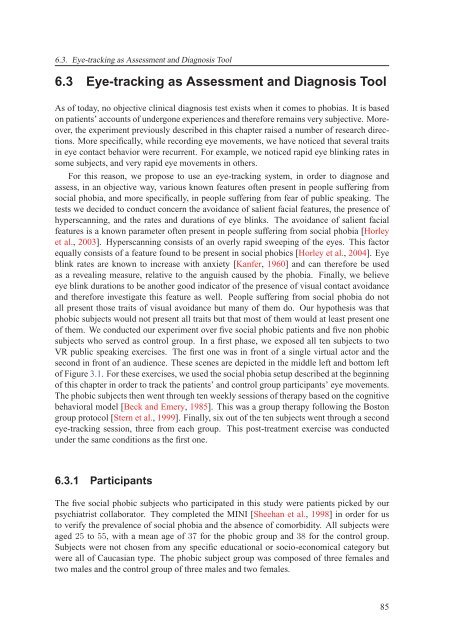Texte intégral / Full text (pdf, 20 MiB) - Infoscience - EPFL
Texte intégral / Full text (pdf, 20 MiB) - Infoscience - EPFL
Texte intégral / Full text (pdf, 20 MiB) - Infoscience - EPFL
You also want an ePaper? Increase the reach of your titles
YUMPU automatically turns print PDFs into web optimized ePapers that Google loves.
6.3. Eye-tracking as Assessment and Diagnosis Tool<br />
6.3 Eye-tracking as Assessment and Diagnosis Tool<br />
As of today, no objective clinical diagnosis test exists when it comes to phobias. It is based<br />
on patients’ accounts of undergone experiences and therefore remains very subjective. Moreover,<br />
the experiment previously described in this chapter raised a number of research directions.<br />
More specifically, while recording eye movements, we have noticed that several traits<br />
in eye contact behavior were recurrent. For example, we noticed rapid eye blinking rates in<br />
some subjects, and very rapid eye movements in others.<br />
For this reason, we propose to use an eye-tracking system, in order to diagnose and<br />
assess, in an objective way, various known features often present in people suffering from<br />
social phobia, and more specifically, in people suffering from fear of public speaking. The<br />
tests we decided to conduct concern the avoidance of salient facial features, the presence of<br />
hyperscanning, and the rates and durations of eye blinks. The avoidance of salient facial<br />
features is a known parameter often present in people suffering from social phobia [Horley<br />
et al., <strong>20</strong>03]. Hyperscanning consists of an overly rapid sweeping of the eyes. This factor<br />
equally consists of a feature found to be present in social phobics [Horley et al., <strong>20</strong>04]. Eye<br />
blink rates are known to increase with anxiety [Kanfer, 1960] and can therefore be used<br />
as a revealing measure, relative to the anguish caused by the phobia. Finally, we believe<br />
eye blink durations to be another good indicator of the presence of visual contact avoidance<br />
and therefore investigate this feature as well. People suffering from social phobia do not<br />
all present those traits of visual avoidance but many of them do. Our hypothesis was that<br />
phobic subjects would not present all traits but that most of them would at least present one<br />
of them. We conducted our experiment over five social phobic patients and five non phobic<br />
subjects who served as control group. In a first phase, we exposed all ten subjects to two<br />
VR public speaking exercises. The first one was in front of a single virtual actor and the<br />
second in front of an audience. These scenes are depicted in the middle left and bottom left<br />
of Figure 3.1. For these exercises, we used the social phobia setup described at the beginning<br />
of this chapter in order to track the patients’ and control group participants’ eye movements.<br />
The phobic subjects then went through ten weekly sessions of therapy based on the cognitive<br />
behavioral model [Beck and Emery, 1985]. This was a group therapy following the Boston<br />
group protocol [Stern et al., 1999]. Finally, six out of the ten subjects went through a second<br />
eye-tracking session, three from each group. This post-treatment exercise was conducted<br />
under the same conditions as the first one.<br />
6.3.1 Participants<br />
The five social phobic subjects who participated in this study were patients picked by our<br />
psychiatrist collaborator. They completed the MINI [Sheehan et al., 1998] in order for us<br />
to verify the prevalence of social phobia and the absence of comorbidity. All subjects were<br />
aged 25 to 55, with a mean age of 37 for the phobic group and 38 for the control group.<br />
Subjects were not chosen from any specific educational or socio-economical category but<br />
were all of Caucasian type. The phobic subject group was composed of three females and<br />
two males and the control group of three males and two females.<br />
85

















